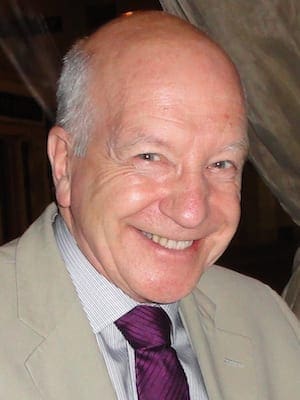“Eye in the Sky” offers a hard examination in the ethics of modern weaponry, the lethal necessities of anti-terrorist operations, the intelligence capacities of advanced technological surveillance techniques, and the tensions between political vacillation and military decision-making.
It is the story of planned indiscriminate death by terrorists, and planned pre-emptive death on the small scale to avoid that greater catastrophe.
Except we spend half an hour getting to know and care for the young girl, playing in her yard, selling her mother’s home-baked bread, and secretly learning math to have a better chance of life and freedom.
The result is a jolting collision of emotions, for the audience and for the key players in the film.
I was gripped for the entire 102 minutes. I cared for this young girl and her family; I cared for the two young drone pilots, remotely observing on screens a child playing with a hula hoop and selling bread, and I cared that within the same compound, unknown to her family, two young radicalized men were being loaded with suicide vests.
And I knew that people were about to die. But who? By whose hand? For what purpose? In what numbers?
The film is a powerful exploration of the moral wilderness that is modern high-tech warfare, with no landmarks of normativity, no oases of certainty, no places to hide from the choices by which people live or die.
It brilliantly exposed the dilemmas facing Western democracies, confronted by enemies who wish their destruction as an ideological and religiously driven goal funded by their own deaths.
The contrast of mindset and worldview between Islamic extremism and Western liberalism creates in this film unbearable tensions between moral imperatives, political aims and risks, and military options.
You can feel, smell and see those tensions for every one of the key characters in the briefing room, the drone control center and the operations center.
We are allowed to observe and overhear the arguments for a strike, the counter arguments for aborting the mission, the search for authorization from government leaders, and all along the chain the conflicted interests of politicians watching their own backs, as elected representatives have to do.
At the heart of the film, a child. The personalizing of the mathematics of collateral damage is brilliantly achieved.
“Eye in the Sky” leaves the viewer no alternative but to join the debate and hear the cost and consequences of action or inaction.
At a key moment, the horrible realities of propaganda and political fallout are clarified.
Let the suicide bombers go and do their murderous worst, and world reaction will demonize Al-Shabab and make the prosecution of war against them more justified.
Eliminate the terrorist cell while knowingly killing an innocent child and her family, and world reaction will condemn an act that is no different from, and no better than, those they oppose.
What this film does is haul us into the operations center of anti-terrorist intelligence, denying the luxury of ignorance or not wanting to know.
The nature of warfare, the military weaponry options, the nature, methods and aims of the often unknown and concealed enemy, the catastrophic loss of life and the extent of human suffering every time a terrorist offensive is successful, the near impotence of military strategy to deal with an enemy whose own death triggers their weapons, all create a nightmare world of dangerous ambiguity, moral confusion and political wariness.
A virtual reality world of remote warfare, drones, satellites and advanced surveillance has changed forever the rules of military engagement.
I came out of the dark cinema, having been glued to a screen showing darkened rooms and computer screens showing images of a world where high-tech surveillance was juxtaposed with bread-making and a hula hoop, and in which a child with a hoped for good future played within yards of two young men whose future was mortgaged to their radicalized goal of self-immolation for purposes of mass death in the name of their god.
I emerged into sunshine and the sound of the waves of the North Sea a hundred yards away. And I asked, which world is real?
The sunlit sea front, or the darkened room with its computerized intelligence, defense and counterterrorist hardware?
The oil lit hut in Somalia where terrorism is prayed over and planned within a liturgy of hate and lethal intent, or the back yard where a child plays in the sunlight from the same sun?
And in all of this, where does the hula hoop and the bread fit in, and who makes the choice whether the child with a hoped for future will be allowed to live into that future, or become one more cipher in the mathematics of collateral damage estimates?
 James Gordon is part-time minister of Montrose Baptist Church in Angus, Scotland, and the former principal of the Scottish Baptist College. He is on the advisory board of the Centre for Ministry Studies, University of Aberdeen, and is honorary lecturer in the School of Divinity, History and Philosophy. A longer version of this movie review first appeared on his blog, Living Wittily, and is used with permission.
James Gordon is part-time minister of Montrose Baptist Church in Angus, Scotland, and the former principal of the Scottish Baptist College. He is on the advisory board of the Centre for Ministry Studies, University of Aberdeen, and is honorary lecturer in the School of Divinity, History and Philosophy. A longer version of this movie review first appeared on his blog, Living Wittily, and is used with permission.
MPAA rating: Rated R for some violent images and language.
Director: Gavin Hood
Writer: Guy Hibbert
Cast: Helen Mirren: Col. Katherine Powell; Aaron Paul: Steve Watts; Alan Rickman: Lt. Gen. Frank Benson; Barkhad Abdi: Jama Farah.
The movie’s website is here.
Part-time minister of Montrose Baptist Church in Angus, Scotland, and the former principal of the Scottish Baptist College. He is on the advisory board of the Centre for Ministry Studies, University of Aberdeen, and is honorary lecturer in the School of Divinity, History and Philosophy.

